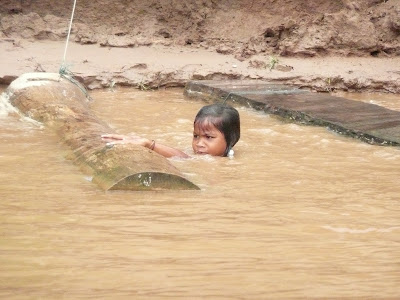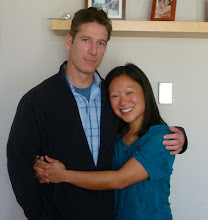First impressions of Vang Vieng - the wild west meets spring break 2010. Over a backdrop of amazing scenery, limestone karsts (mountains) surrounded by rice fields and the Nam Song River and a smorgasbord of outdoor activities (rock climbing, kayaking, caving, rafting, cycling, you name it) lies a little town that caters to young backpackers looking for an adrenaline fix and a dose of all things Western - food, alcohol, drugs, and television sitcoms. Although we had to overcome our first impressions of the backpacker circus, Steve and I spent 4 exhilarating days here where we attempted to blend in with the other early twenty-somethings and Steve had his first Spring Break experience, albeit 20 years late!.
One day we rented mountain bikes and completed a very scenic 30km ride through rice fields and villages on our way to Poukham cave. It had rained the previous day which made for a slow, muddy slog, but it was well worth it. We saw great shots of village life, the fog rolling in over the karsts, and had a nice picnic and swim along the way.
The next day we did a rock climbing excursion which happened to be on the karst that our room overlooks. The rockface was a nice sticky, textured limestone with lots of good handholds from rainwater carving channels through the rockface and some pretty challenging overhangs. It was great climbing again after a 3 month hiatus and Steve was the climbing machine as his lighter, leaner bod really helped propel him up the mountain.
Our last day we partook in the activity that has put Vang Vieng on the map - tubing. It sounds like an innocent enough of an activity, but when you mix in lots of alcohol and drugs, water park rides, and a Spring Break mentality, you get tubing a la Vang Vieng. We joined the parade of tubers in their requisite uniforms - "In the Tube" tanktops, shorts, flip flops, dry bag pouches, and tractor tire tubes. A tuk tuk took us up the river about 7km to the drop off point and we were greeted with our first 2 bars before we even got to river's edge. After pounding a beer and a few rounds on the water slide, we finally got into the water. We only floated about 50m before we were thrown weighted ropes and pulled back into shore to partake in shots of snake whisky (yes, there is really a small cobra at the bottom of the bottle) and the big rope swing. Steve and I took turns on the rope swing and then we had the great idea of doing a double jump. Not realizing that the additional weight would cause us to go a lot faster, I hit the water with what felt like a powerful punch to the chest. Steve didn't get off unscathed from the rope swing either with a couple of bruises and scrapes on his legs, nothing a few beers and a round of beer pong couldn't fix. Not sure where Steve got his skillz, but he was certainly a player to contend with, impressing all with his signature air shot.
After 3 hours of moving from bar to bar along a short stretch of river, it started to rain really hard, which just kicked up the Spring Break atmosphere into overdrive with a big dance party in the rain. Getting a little cold, we decided to turn it in and left our young friends to tube down the river alone. We hobbled out of Vang Vieng a little beat-up and exhausted, but a slight sense of satisfaction knowing that we can still keep up with the young-uns.























